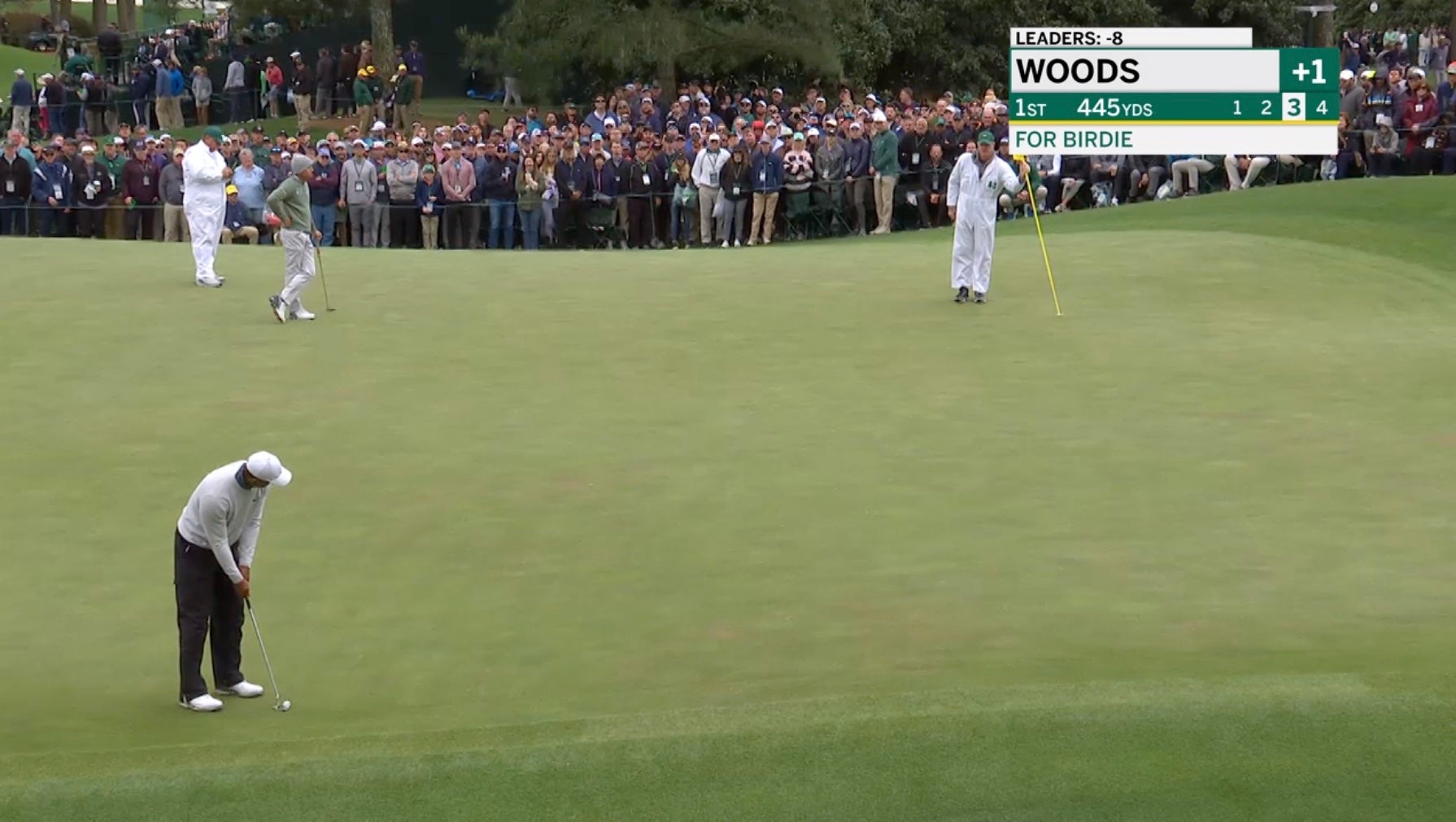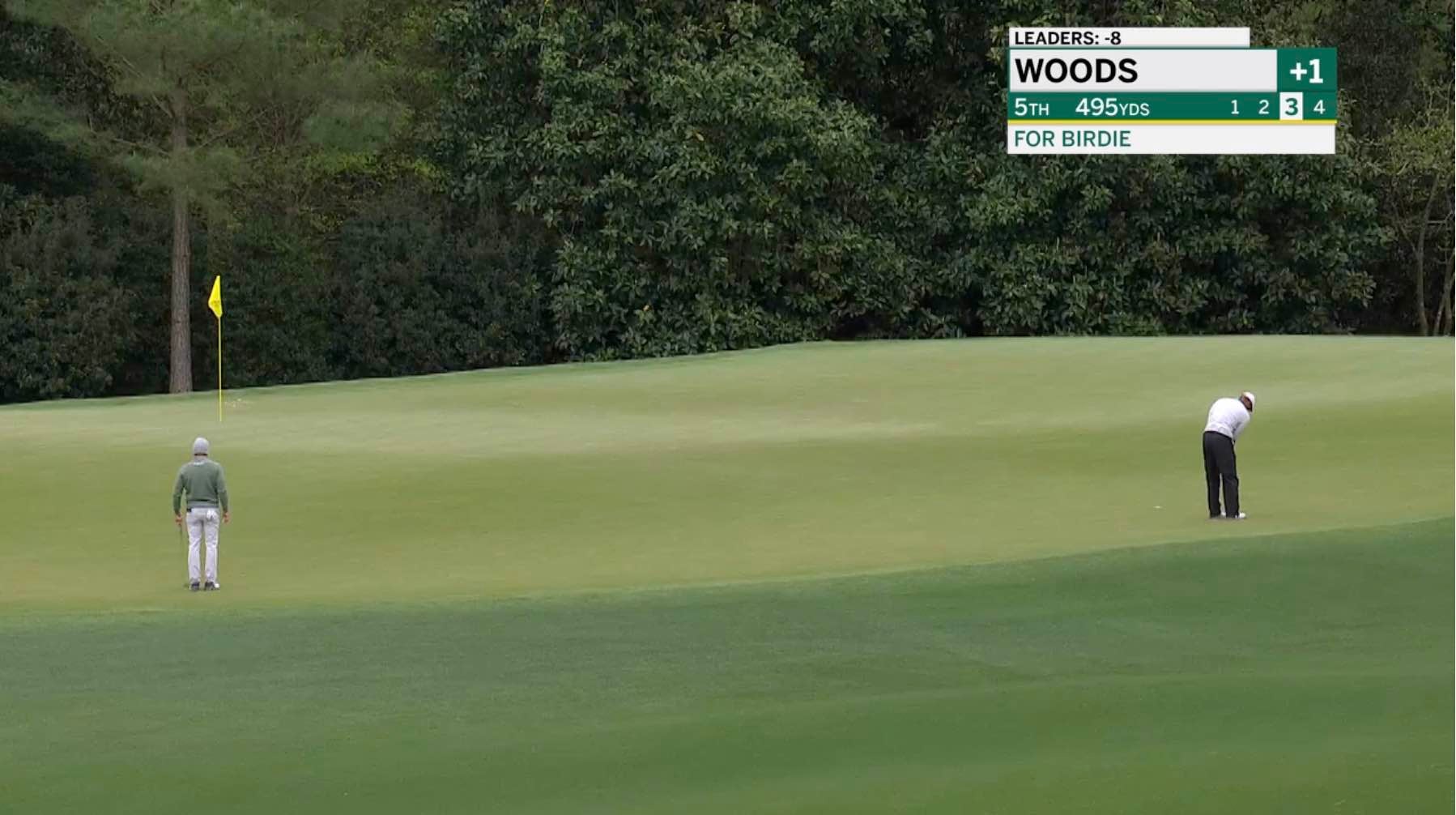
Tiger Woods left himself in spots that required extremely good putting.
Masters.com
AUGUSTA, Ga. — It wasn’t just his leg, or back, that failed Tiger Woods on Saturday at the Masters. It was his putter.
The three don’t exist in isolation, of course. The temperature dropped as players arrived to the course on Saturday morning, and the clear blue skies of the previous two days had been blanketed in gloomy overcast. The sweaters came out for the first time of the week. Everyone in the golf world and beyond knew these were not the conditions an ailing Woods needed to feel his best.
Yet, on paper at least, the five-time Masters champion hit the ball fairly well. He hit more fairways (11) and greens in regulation (11) on Saturday than in his previous two rounds. The TV broadcast clocked his ball speed numerous times dancing around 170 mph — just a few mph shy of where he was on the driving range earlier this week, which makes sense given the colder conditions.
“For the most part I didn’t feel like I hit it that bad,” he said after his third-round 78. “The issue was that I had four three-putts and a four-putt.”
It’s certainly true that Woods didn’t putt well on Saturday. But the sad irony of his third round is that his poor putting wasn’t the cause, but an effect of hitting the ball slightly better on Saturday than his previous two rounds.
The challenge and charm of Augusta National is in its rolling terrain. It weaves up and down hills. Every iron shot players face is from some kind of sloped lie, and the greens are no different. They run up and down tiers, and Adam Scott and Kevin Na, among others, proved a long putt on the wrong tier can lead to big numbers.
The brilliance of Woods’ first round was that he made life easier for himself despite not hitting the ball particularly well. He was playing to extremely safe areas, and missing in spots that left himself relatively easy chips with lots of green to work with. On Saturday, Woods was navigating through a variety of safe spots, but he left himself with lots of long and undulating putts instead.
Take the first hole, for example. A green in regulation — he had missed it the previous two days — but one that left him a winding 51-footer back up the hill. He lagged it to seven feet and missed the putt for bogey.

Woods’ birdie putt on the 1st hole.
Masters.com
His four-putt 5th hole started with a 60-footer. The angle viewers saw on the broadcast tells the entire story. He navigated his ball up a giant seam running down the middle of the green and watched his ball move both directions along the way. He actually did quite well to leave himself six feet.

Woods’ birdie try on the 5th hole. He four-putted here.
Masters.com
We saw Woods leave himself in spots like this time and time again.
On the 9th, he lagged his 60-footer from the fringe to six feet; on the 16th, his task was to navigate more than 40 feet back up the hill from a similar area Na five-putted from; on the 17th, he needed to putt through the fringe from 49 feet and left himself 18 feet. And, on his final hole, he sent his putt from 59 feet through the green’s swale and seven feet past the hole.
The tour average between five and 10 feet — where most of those second putts were hit from — is just north of 56 percent. Woods missed all of the ensuing putts.

Woods put himself in a few tricky spots on the greens.
Masters.com
It wasn’t a bad strategy Woods opted for, but it is one heavily dependent on good putting, both from short and long range. And for a man battling injuries and limited in his full-swing practice for the better part of two years, it’s probably his best option. But it’s still a lot of pressure for Woods to put on one specific area of his game. And on Saturday at Augusta National, it buckled.
“I just couldn’t get a feel, I couldn’t get a feel for getting comfortable over the ball,” he said. “My posture, my right hand, my release, I just couldn’t find it. Trying different things, taking extra practice strokes, feel the swing of the putterhead, nothing worked. Even hitting as many putts as I did, you’d think I’d figure it out somewhere along the line but it just didn’t happen.”
The Woods of old didn’t need to rely on one area of his game above all others. He had all the tools and often wielded them simultaneously. Woods doesn’t enjoy that luxury anymore. His new normal means one sometimes needs to cover for the other. It wasn’t there during his third round, and it left everything else exposed.








